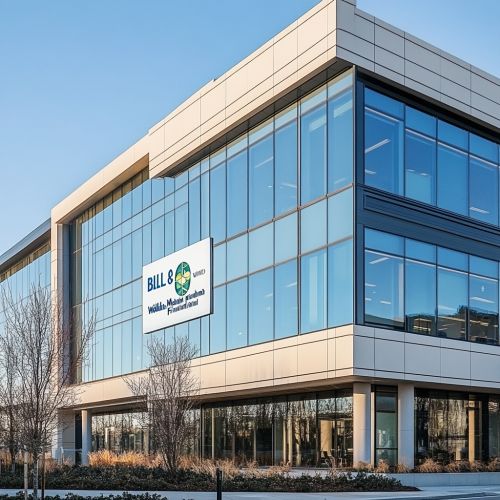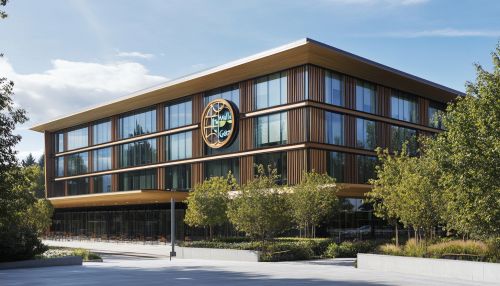Bill & Melinda Gates Foundation: Difference between revisions
No edit summary |
No edit summary |
||
| Line 29: | Line 29: | ||
In the realm of financial inclusion, the foundation works to expand access to affordable and reliable financial services for the poor, including savings accounts, credit, and insurance. It collaborates with financial institutions, mobile network operators, and governments to develop innovative solutions that meet the needs of underserved populations. | In the realm of financial inclusion, the foundation works to expand access to affordable and reliable financial services for the poor, including savings accounts, credit, and insurance. It collaborates with financial institutions, mobile network operators, and governments to develop innovative solutions that meet the needs of underserved populations. | ||
[[Image:Detail-99411.jpg|thumb|center|Modern office building with the Bill & Melinda Gates Foundation logo on the facade.]] | [[Image:Detail-99411.jpg|thumb|center|Modern office building with the Bill & Melinda Gates Foundation logo on the facade.|class=only_on_mobile]] | ||
[[Image:Detail-99412.jpg|thumb|center|Modern office building with the Bill & Melinda Gates Foundation logo on the facade.|class=only_on_desktop]] | |||
== Governance and Leadership == | == Governance and Leadership == | ||
Latest revision as of 19:55, 29 October 2024
Overview
The Bill & Melinda Gates Foundation is a private philanthropic organization founded by Bill Gates and Melinda French Gates in 2000. It is headquartered in Seattle, Washington, and is recognized as one of the largest private foundations in the world. The foundation's primary goals are to enhance healthcare, reduce extreme poverty, and expand educational opportunities and access to information technology. Its endowment, valued at over $50 billion, enables it to fund a wide range of initiatives globally.
History and Formation
The foundation was established through the merger of the William H. Gates Foundation and the Gates Learning Foundation. Initially, it focused on global health and education, reflecting the founders' interests and expertise. Over time, its scope expanded to include agricultural development, financial services for the poor, and emergency relief efforts.
The foundation's approach is characterized by its emphasis on data-driven decision-making and partnerships with governments, non-profits, and the private sector. This collaborative model aims to leverage resources and expertise to achieve sustainable impact.
Key Focus Areas
Global Health
One of the foundation's primary areas of focus is global health. It invests heavily in research and development for vaccines, drugs, and diagnostics to combat infectious diseases such as HIV/AIDS, malaria, and tuberculosis. The foundation also supports initiatives to improve maternal and child health, nutrition, and sanitation.
The foundation's efforts in global health are guided by the belief that all lives have equal value and that everyone should have the opportunity to lead a healthy life. It collaborates with organizations like the World Health Organization and the Global Fund to Fight AIDS, Tuberculosis and Malaria to maximize its impact.
Education
In the field of education, the foundation aims to ensure that all students have access to a high-quality education that prepares them for success in college and their careers. It focuses on improving K-12 education in the United States by supporting initiatives that enhance teaching effectiveness, develop innovative learning models, and promote equitable access to educational resources.
The foundation also invests in postsecondary education, with an emphasis on increasing college completion rates among low-income and minority students. It supports efforts to redesign higher education institutions to better meet the needs of today's students.
Economic Development
The foundation's work in economic development is centered on empowering individuals and communities to lift themselves out of poverty. It supports initiatives that promote agricultural development, financial inclusion, and entrepreneurship. The foundation's agricultural development program aims to increase the productivity and income of smallholder farmers in developing countries by providing access to improved seeds, technologies, and markets.
In the realm of financial inclusion, the foundation works to expand access to affordable and reliable financial services for the poor, including savings accounts, credit, and insurance. It collaborates with financial institutions, mobile network operators, and governments to develop innovative solutions that meet the needs of underserved populations.


Governance and Leadership
The foundation is governed by a board of trustees, which includes Bill Gates, Melinda French Gates, and Warren Buffett. The board is responsible for setting the strategic direction of the foundation and ensuring that its resources are used effectively to achieve its mission.
The foundation's day-to-day operations are managed by a team of executives and program officers with expertise in various fields. The leadership team is committed to transparency and accountability, regularly publishing reports on the foundation's activities and outcomes.
Partnerships and Collaborations
Collaboration is a cornerstone of the foundation's approach to philanthropy. It partners with a wide range of organizations, including governments, non-profits, academic institutions, and the private sector, to achieve its goals. These partnerships are designed to leverage the strengths and resources of each partner to create sustainable solutions to complex global challenges.
The foundation also works closely with grantees to ensure that funded projects are aligned with its strategic priorities and have the potential for significant impact. It provides technical assistance and capacity-building support to help grantees achieve their objectives.
Criticisms and Controversies
Despite its significant contributions to global health and development, the foundation has faced criticism and controversy. Some critics argue that its influence on public policy and research agendas is disproportionate, given its financial resources. Others have raised concerns about the foundation's focus on technological solutions to complex social problems, which may overlook the root causes of poverty and inequality.
The foundation has responded to these criticisms by emphasizing its commitment to transparency and accountability. It regularly engages with stakeholders to solicit feedback and improve its practices.
Future Directions
Looking ahead, the foundation plans to continue its work in global health, education, and economic development while exploring new areas of impact. It is particularly interested in harnessing the potential of digital technologies to address pressing social challenges and improve the lives of people around the world.
The foundation is also committed to fostering innovation and scaling successful interventions to reach more people. It will continue to invest in research and development, data-driven decision-making, and partnerships to achieve its mission.
